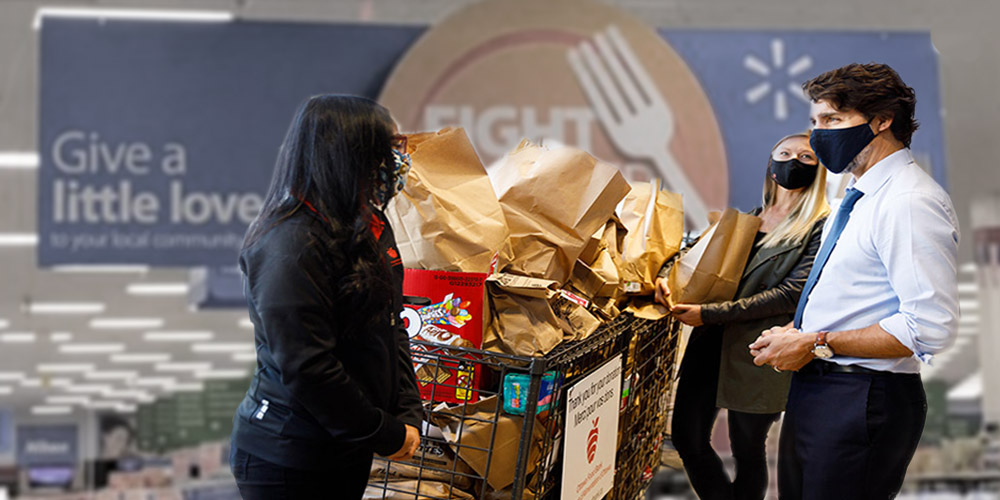
In 2016, Food Banks Canada — which, as its name suggests, is the national body representing Canada’s food banks — presented an Award of Excellence to Walmart Canada. The famously low-paying, anti-union retail giant was honoured not for generating clients but for its “extensive philanthropy program.”
“Recognizing the serious issue of food insecurity in Canada, Walmart Canada is committed to providing ongoing and predictable resources to Food Banks Canada,” the charity wrote in a citation.
In 2013, they named Walmart their Innovator of the Year, and in 2018 their Donor of the Year. By the time of the latter, a Walmart VP had a spot on the nonprofit’s board; by 2021, he was its chair. A similar national group in the U.S. sports a former Walmart exec as its CEO.
But if every billionaire is a policy failure — and there are at least five in the family whose late patriarch founded Walmart — then so is every food bank.
On this week’s CANADALAND, reporter Cherise Seucharan explains how a band-aid solution from the 1980s ended up sticking around, held up by civil society as a point of pride rather than one of shame:
The first food bank in Canada started in Edmonton in 1981 as a response to the ongoing recession, when Canadian unemployment got as high as 12% and there was a crisis in food commodities worldwide. “In the U.S., this sort of food-bank model had started, and so a lot of small community churches, that type of thing, saw that model and were like, okay, we’re going to try this just as a temporary measure to feed people who were unemployed, couldn’t find work, or couldn’t afford food,” Cherise explains.
But over the course of the decade, as an increasing number of Canadians came to need food banks, more and more were created to meet the demand. By 1989, former NDP leader Ed Broadbent was telling the House of Commons that there were more food banks in Toronto than there were McDonald’s.
“Canada is unique in this regard,” Valerie Tarasuk, a University of Toronto professor of nutritional sciences who’s an expert on food insecurity, says on the show. “You know, there are food banks, for sure, in the United States and in the United Kingdom, and they’re moving along in Europe, I believe. But from what I can figure out, we’re the only country that continues to have this craziness where we’ve got our prime minister and our provincial premiers doing photo ops over Thanksgiving at food banks. And I’m sure we’ll see that again at Christmastime.”
She said you wouldn’t see Joe Biden doing that, because, in the U.S., there appears to be an understanding that the need for food banks is not a good thing.
“Food banks aren’t wrong,” Cherise says. “But the problem is that if you’re at the point of needing one, so many other things have failed where they should have succeeded. We have so many opportunities to create policy to prevent people from being food insecure that we simply haven’t.”
Like many charities, food banks attempt to fill in a gap being left by the state. In this case, that gap is people’s ability to obtain basic sustenance.
“What we need is to shift away from this idea of food as a commodity and towards food as a human right,” says FoodShare’s jade guthrie. “I don’t think that the government has done anything to advance the right to food for people living in Canada. I think the fact that they’ve invested so much money in a food-banking system only goes to show that they are not interested in framing food as a human right.”
To meaningfully tackle food insecurity would involve closing the gap between the money that people have and the money they would require to feed themselves. Everything from offering more affordable housing options to meaningfully regulating precarious employment could make a difference with that.
But advocates believe the most direct and effective solution would likely be a universal basic income.
Per Professor Tarasuk, the 5.8 million people in Canada who are food insecure mostly belong to three lower-income groups: people in lower-wage jobs, people on social assistance, and families with children. Notably, however, seniors don’t tend to be among them.
She points to a 2013 University of Calgary study in which researchers looked at low-income, unattached Canadians in their 50s, 60s, and 70s [pdf]. “They showed this dramatic drop in the probability of food insecurity when people hit 65,” she says. “Why? Because then they’re entitled to absolute income security with the old-age pension and guaranteed income supplement.” Unlike social assistance rates across most of Canada, those income sources are indexed to inflation.
The question, as Cherise puts is, is do we want to solve a long-term problem or a short-term problem?
She points to the $200 million that Prime Minister Justin Trudeau pledged to food banks near the start of the pandemic.
“So we spent $200 million to not solve a problem,” she says.
Top image consists of a 2020 pic from the Prime Minister’s Office of Trudeau helping out the Ottawa Food Bank at a local Metro, as well as an image via Food Banks Canada of signage from Walmart’s “Fight Hunger. Spark Change” campaign circa 2018.